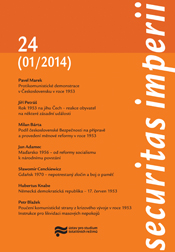Rok 1953 na jihu Čech – reakce obyvatel na některé zásadní události
The year 1953 in South Bohemia – the population’s response to some major events
Author(s): Jiří PetrášSubject(s): Geography, Regional studies, Security and defense, Post-War period (1950 - 1989), History of Communism
Published by: Ústav pro studium totalitních režimů
Summary/Abstract: For citizens of Czechoslovakia, the year 1953 saw many fatal events. In the early fifties, numerous villages in the Czech borderland were destroyed as part of the expansion of the forbidden border zone. This drastic step affected, for example, Rapšach and the nearby villages of Nová Ves near Klikov (Najdorf) and Kunšach. The actual act of resettling the unreliable population was planned to start on 25 May 1953, and it was supervised in the villages by the Regional Resettlement Commission. Other dramatic events took place in the country, in connection with the collectivization of agriculture (e.g. in the traditional farming village of Plástovice). The most common reason for the persecution of local farmers by the state was failure to meet the mandatory quotas. On the one hand, the state needed regular and sufficient supplies for the population, but, on the other hand, the quotas were used in the fight against private farmers as part of the collectivization process. Farmers did not or, more precisely, could not meet these quotas for a number of reasons (farm labourers leaving after the war, bad weather, etc.). In some places, Local National Committees proposed mitigation of punishment or alternative solutions, confirmed the failure to meet the quotas as described by the punished farmers in their appeals, and even pointed to the interest of the village. The monetary reform introduced in 1953 was a traumatic event for the national community. The situation in the region was closely monitored by both the Public Security Service and the State Security Service at that time. However, the number of strikes and their active participants was not as high, so we cannot speak of any mass resistance of the population. Furthermore, it is far from truth that the number of strikes and participants was higher in large industrial cities – see the example of České Budějovice, Písek, Tábor and Jindřichův Hradec. The most dramatic situation occurred in Strakonice and Vimperk, where the army had to intervene.
Journal: Securitas imperii
- Issue Year: 2014
- Issue No: 24
- Page Range: 36-51
- Page Count: 16
- Language: Czech

